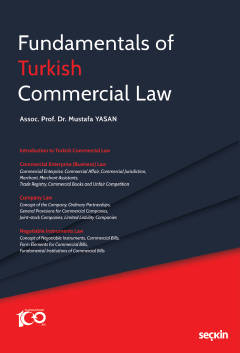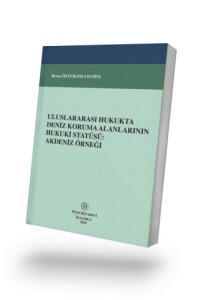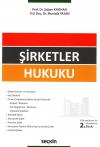9789750283611
392925

https://www.legalkitabevi.com/fundamentals-of-turkish-commercial-law-.htm
Fundamentals of Turkish Commercial Law
266.00
Assoc. Prof. Dr. Mustafa YASAN
İÇİNDEKİLER
Table of Contents
Foreword
7
CHAPTER ONE
COMMERCIAL ENTERPRISE / BUSINESS LAW
I. INTRODUCTION TO TURKISH COMMERCIAL LAW
17
A. Concept of Commerce
17
B. Unique Character of Commercial Law
17
C. Classification of Commercial Law
18
D. Relationship between Commercial Law and Economic Law
18
E. Globalisation of Commercial Law
19
F. History of Commercial Law
20
G. Structure of the Turkish Code of Commerce
21
H. Commercial Law Systems
21
1. Subjective System
22
2. Objective System
22
3. Modern System
22
4. Turkish Code of Commerce’s Unique Character
22
II. COMMERCIAL ENTERPRISE
23
A. Conceptual Elements of Commercial Enterprise
23
B. Asset Elements of Commercial Enterprise
23
C. Structural Elements of Commercial Enterprise
24
1. Centre
24
2. Branch
25
a. d Elements of Branch
25
b. Consequences Connected to Being a Branch
25
D. Transfer of Commercial Enterprise
26
1. Essentials of Transfer of Commercial Enterprise
26
2. Scope of the Commercial Enterprise Transfer
27
3. Legal Consequences of the Commercial Enterprise Transfer
27
III. COMMERCIAL AFFAIR
28
A. Conceptual Elements of Commercial Affairs
28
B. Particular Legal Consequences of Having the Nature of Commercial Affair
29
1. Presumption of Joint Liability
29
2. Presumption of Joint Surety / Bail
29
3. Different Provisions Related to Interest in Commercial Affairs
30
IV. COMMERCIAL PROVISIONS / TERMS
31
V. COMMERCIAL JURISDICTION
31
A. Commercial Cases / Lawsuits
31
1. Absolute Commercial Cases
32
2. Commercial Cases Arising from Remittance Agreement, Retention Agreement and the Copyright
32
3. Relative Commercial Cases
32
B. Competent Courts in Commercial Litigation
32
C. Special Procedural Rules to be Applied in Commercial Cases / Lawsuits
33
VI. MERCHANT (TRADER)
34
A. Real Person Merchant
34
B. Legal Person (Entity) Merchants
35
1. Commercial / Trading Companies
35
2. Associations
35
3. Foundations
35
4. Public Economic Enterprises
35
C. Consequences Linked to Being Merchant
35
1. Being Subject to Bankruptcy
36
2. Keeping Commercial Books
36
3. Being Subject to Commercial Customs
36
4. Obligation to Behave like a Prudent Businessman
36
5. Using a Trading Name
36
6. Ability to Charge Fee and Interest
37
7. Fulfilling the Registration Obligation
37
8. Benefiting from the Right of Stoppage Easily
37
D. Exceptional Provisions that can be applied to Artisans
37
VII. MERCHANT ASSISTANTS
38
A. Types of Merchant Assistants
38
1. Commercial Representative
38
2. Commercial Agent
38
3. Marketer
39
4. Broker
39
5. Agent
39
6. Arbitrager
39
7. Freight Forwarder
40
B. Classifications of Merchant Assistants
40
1. Dependent merchant assistants – Independent merchant assistants
40
2. Merchant assistants who have a permanent relationship with the merchant – Merchant assistants who have a temporary relationship with the merchant
40
3. Merchant assistants regulated in the Turkish Code of Obligations–Merchant assistants regulated in the Turkish Code of Commerce
41
VIII. TRADE REGISTRY
41
A. Transactions in the Trade Register
41
1. Types of Trade Register Transactions
41
2. Trade Register Procedure
42
3. Possible Results of the Examine by Trade Registry Office
43
4. Temporary Registration
43
5. Effects of Registration
43
a. Founding–Explanatory Effect of Registration
43
aa. Founding Effect of Registration
43
bb. Explanatory Effect of Registration
44
b. Positive–Negative Effect of Registration
44
aa. Positive Effect of Registration
44
bb. Negative Effect of Registration
44
B. Announcement
44
IX. COMMERCIAL BOOKS
45
A. The Scope (Elements) of the Commercial Bookkeeping Obligation
45
B. Preserving the Commercial Books
46
C. Legal Consequences as Sanctions of Non–Performance of Commercial Bookkeeping Obligation
46
D. Evidence Capacity of Commercial Books
47
X. CURRENT ACCOUNT
47
A. Current Account Contract
47
B. The Functioning of Current Account
48
C. Termination of Current Account
48
XI. TRADING NAME AND BUSINESS NAME
49
A. Trading Name
49
1. Format of Trading Name
49
a. Core of the Trading Name
49
b. Appendix of the Trading Name
50
2. Effect of Trading Name Registration
50
B. Business Name
50
XII. UNFAIR COMPETITION
51
A. Unfair Competition Practices
51
B. Legal Consequences of Unfair Competition
51
CHAPTER TWO
COMPANY LAW
I. CONCEPT OF THE COMPANY
53
A. Definition
53
B. Elements
53
1. Personal Element
53
2. Asset Element
54
3. Contract Element
55
4. Common Purpose Element
55
5. Active Effort Element
56
C. Classification of the Companies
56
1. Companies With Legal Personalities – Companies Without Legal Personalities
56
2. Companies According to the Laws in which They Are Regulated
57
3. Companies Subject to Limited Liability – Companies Subject to Unlimited Liability
57
4. Personal Companies – Capital Companies
57
II. ORDINARY PARTNERSHIPS
58
A. Characteristic Features of Ordinary Partnerships
58
B. General Features of Ordinary Partnerships
58
C. Establishment of Ordinary Partnerships
58
D. Functioning of Ordinary Partnerships
58
1. Management of Ordinary Partnerships
58
2. Representation of Ordinary Partnerships
59
3. Property Regime in Ordinary Partnerships
59
4. Share of Profit and Loss by the Partners
59
E. Right for Audit and Duty of Loyalty of the Partners
60
F. Liability Regime in Ordinary Partnerships
60
G. Termination of Ordinary Partnerships
60
III. GENERAL PROVISIONS OF COMMERCIAL COMPANIES
61
A. Determination and Classification of Commercial Companies
61
B. Capacity of the Commercial Companies to Acquire Rights and Undertake Debts
62
C. Capital Investment Liability for the Partners in Commercial Companies
62
D. Claims of Personal Creditors of the Partners of the Commercial Companies
63
E. Structural Changes in Commercial Companies
63
1. Merger
63
a. Types of Mergers
63
b. Preconditions for Merger
64
c. Stages of Merger
64
2. Type Change (Conversion)
65
a. Preconditions for Type Change
65
b. Stages of Type Change
65
3. Division
65
a. Division Forms
65
b. Preconditions of Division
66
c. Stages of Division
66
IV. JOINT–STOCK COMPANIES
66
A. General Features of Joint–Stock Companies
66
B. Establishment of Joint–stock Companies
67
C. Bodies (Organs) of Joint–Stock Companies
68
1. General Assembly
68
2. Board of Directors
69
D. Audit in Joint–Stock Companies
70
E. Capital System in Joint–Stock Companies
70
F. Capital Shares
71
G. Termination of the Joint–Stock Companies
71
1. Reasons for Termination
71
2. Moment of the Termination
72
V. LIMITED LIABILITY COMPANIES
72
A. General Features of Limited Liability Companies
72
B. Establishment of the Limited Liability Companies
73
C. Bodies of the Limited Liability Company
74
1. General Assembly
74
2. Directors
74
D. Capital Shares in Limited Liability Companies
75
E. Termination of Limited Liability Companies
75
1. Reasons for Termination
75
2. Moment of the Termination
76
CHAPTER THREE
NEGOTIABLE INSTRUMENTS LAW
I. CONCEPT OF NEGOTIABLE INSTRUMENTS
77
A. Definition
77
B. Elements
77
1. Bill (Deed)
77
2. Right
78
3. Close and Strong Relationship Between Bill and Right
78
C. Characteristic Features of Negotiable Instruments
78
1. Abstractness
78
2. Limited Number (Numerus Clausus) Principle
79
3. Subject to Strict and Aggravated Form Conditions
79
D. Classification of the Negotiable Instruments
79
II. NEGOTIABLE INSTRUMENTS ACCORDING TO TRANSFER FORMS
80
A. Negotiable Instruments Written to the Register (Name)
80
B. Negotiable Instruments Written to the Order
81
C. Negotiable Instrument Written to the Bearer
81
D. Type Change of Negotiable Instruments
81
E. Cancellation of Negotiable Instruments due to Loss
82
III. COMMERCIAL BILLS
82
A. Types of Commercial Bills
82
B. Characteristic Features of Commercial Bills
83
C. Relationship Between Commercial Bills and Basic Debt Relationship
84
D. The Capacity ment for Commercial Bills
85
IV. FORM ELEMENTS FOR THE VALIDATION OF COMMERCIAL BILLS
85
A. Bill of Exchange
85
B. Promissory Note
86
C. Cheque
87
V. THE FUNDAMENTAL INSTITUTIONS AND CONCEPTS OF COMMERCIAL BILLS
89
A. Institution of Acceptance in Bill of Exchange
89
B. Transfer of Commercial Bills
89
C. Bill Guarantee in Commercial Bills
90
D. Payment in Commercial Bills
91
E. Non–Payment of Commercial Bills
92
F. Application Right
92
G. Statute of Limitations in Commercial Bills
93
H. Exceptional Claim Ways in Case of Loss of Right in Commercial Bills
93
I. Special Regulation of Cheque in Cheque Code Numbered 5941
94
SAMPLE QUESTIONS
95
Multiple Choices Questions (Fill in the blanks with the correct choice)
105
Commercial Law I
109
Commercial Law II
145
Commercial Law III
177
RECOMMENDED RESOURCES
197
1. Commercial Enterprise / Business Law
197
2. Company Law
197
3. Negotiable Instruments Law
198
Assoc. Prof. Dr. Mustafa YASAN
İÇİNDEKİLER
Table of Contents
Foreword
7
CHAPTER ONE
COMMERCIAL ENTERPRISE / BUSINESS LAW
I. INTRODUCTION TO TURKISH COMMERCIAL LAW
17
A. Concept of Commerce
17
B. Unique Character of Commercial Law
17
C. Classification of Commercial Law
18
D. Relationship between Commercial Law and Economic Law
18
E. Globalisation of Commercial Law
19
F. History of Commercial Law
20
G. Structure of the Turkish Code of Commerce
21
H. Commercial Law Systems
21
1. Subjective System
22
2. Objective System
22
3. Modern System
22
4. Turkish Code of Commerce’s Unique Character
22
II. COMMERCIAL ENTERPRISE
23
A. Conceptual Elements of Commercial Enterprise
23
B. Asset Elements of Commercial Enterprise
23
C. Structural Elements of Commercial Enterprise
24
1. Centre
24
2. Branch
25
a. d Elements of Branch
25
b. Consequences Connected to Being a Branch
25
D. Transfer of Commercial Enterprise
26
1. Essentials of Transfer of Commercial Enterprise
26
2. Scope of the Commercial Enterprise Transfer
27
3. Legal Consequences of the Commercial Enterprise Transfer
27
III. COMMERCIAL AFFAIR
28
A. Conceptual Elements of Commercial Affairs
28
B. Particular Legal Consequences of Having the Nature of Commercial Affair
29
1. Presumption of Joint Liability
29
2. Presumption of Joint Surety / Bail
29
3. Different Provisions Related to Interest in Commercial Affairs
30
IV. COMMERCIAL PROVISIONS / TERMS
31
V. COMMERCIAL JURISDICTION
31
A. Commercial Cases / Lawsuits
31
1. Absolute Commercial Cases
32
2. Commercial Cases Arising from Remittance Agreement, Retention Agreement and the Copyright
32
3. Relative Commercial Cases
32
B. Competent Courts in Commercial Litigation
32
C. Special Procedural Rules to be Applied in Commercial Cases / Lawsuits
33
VI. MERCHANT (TRADER)
34
A. Real Person Merchant
34
B. Legal Person (Entity) Merchants
35
1. Commercial / Trading Companies
35
2. Associations
35
3. Foundations
35
4. Public Economic Enterprises
35
C. Consequences Linked to Being Merchant
35
1. Being Subject to Bankruptcy
36
2. Keeping Commercial Books
36
3. Being Subject to Commercial Customs
36
4. Obligation to Behave like a Prudent Businessman
36
5. Using a Trading Name
36
6. Ability to Charge Fee and Interest
37
7. Fulfilling the Registration Obligation
37
8. Benefiting from the Right of Stoppage Easily
37
D. Exceptional Provisions that can be applied to Artisans
37
VII. MERCHANT ASSISTANTS
38
A. Types of Merchant Assistants
38
1. Commercial Representative
38
2. Commercial Agent
38
3. Marketer
39
4. Broker
39
5. Agent
39
6. Arbitrager
39
7. Freight Forwarder
40
B. Classifications of Merchant Assistants
40
1. Dependent merchant assistants – Independent merchant assistants
40
2. Merchant assistants who have a permanent relationship with the merchant – Merchant assistants who have a temporary relationship with the merchant
40
3. Merchant assistants regulated in the Turkish Code of Obligations–Merchant assistants regulated in the Turkish Code of Commerce
41
VIII. TRADE REGISTRY
41
A. Transactions in the Trade Register
41
1. Types of Trade Register Transactions
41
2. Trade Register Procedure
42
3. Possible Results of the Examine by Trade Registry Office
43
4. Temporary Registration
43
5. Effects of Registration
43
a. Founding–Explanatory Effect of Registration
43
aa. Founding Effect of Registration
43
bb. Explanatory Effect of Registration
44
b. Positive–Negative Effect of Registration
44
aa. Positive Effect of Registration
44
bb. Negative Effect of Registration
44
B. Announcement
44
IX. COMMERCIAL BOOKS
45
A. The Scope (Elements) of the Commercial Bookkeeping Obligation
45
B. Preserving the Commercial Books
46
C. Legal Consequences as Sanctions of Non–Performance of Commercial Bookkeeping Obligation
46
D. Evidence Capacity of Commercial Books
47
X. CURRENT ACCOUNT
47
A. Current Account Contract
47
B. The Functioning of Current Account
48
C. Termination of Current Account
48
XI. TRADING NAME AND BUSINESS NAME
49
A. Trading Name
49
1. Format of Trading Name
49
a. Core of the Trading Name
49
b. Appendix of the Trading Name
50
2. Effect of Trading Name Registration
50
B. Business Name
50
XII. UNFAIR COMPETITION
51
A. Unfair Competition Practices
51
B. Legal Consequences of Unfair Competition
51
CHAPTER TWO
COMPANY LAW
I. CONCEPT OF THE COMPANY
53
A. Definition
53
B. Elements
53
1. Personal Element
53
2. Asset Element
54
3. Contract Element
55
4. Common Purpose Element
55
5. Active Effort Element
56
C. Classification of the Companies
56
1. Companies With Legal Personalities – Companies Without Legal Personalities
56
2. Companies According to the Laws in which They Are Regulated
57
3. Companies Subject to Limited Liability – Companies Subject to Unlimited Liability
57
4. Personal Companies – Capital Companies
57
II. ORDINARY PARTNERSHIPS
58
A. Characteristic Features of Ordinary Partnerships
58
B. General Features of Ordinary Partnerships
58
C. Establishment of Ordinary Partnerships
58
D. Functioning of Ordinary Partnerships
58
1. Management of Ordinary Partnerships
58
2. Representation of Ordinary Partnerships
59
3. Property Regime in Ordinary Partnerships
59
4. Share of Profit and Loss by the Partners
59
E. Right for Audit and Duty of Loyalty of the Partners
60
F. Liability Regime in Ordinary Partnerships
60
G. Termination of Ordinary Partnerships
60
III. GENERAL PROVISIONS OF COMMERCIAL COMPANIES
61
A. Determination and Classification of Commercial Companies
61
B. Capacity of the Commercial Companies to Acquire Rights and Undertake Debts
62
C. Capital Investment Liability for the Partners in Commercial Companies
62
D. Claims of Personal Creditors of the Partners of the Commercial Companies
63
E. Structural Changes in Commercial Companies
63
1. Merger
63
a. Types of Mergers
63
b. Preconditions for Merger
64
c. Stages of Merger
64
2. Type Change (Conversion)
65
a. Preconditions for Type Change
65
b. Stages of Type Change
65
3. Division
65
a. Division Forms
65
b. Preconditions of Division
66
c. Stages of Division
66
IV. JOINT–STOCK COMPANIES
66
A. General Features of Joint–Stock Companies
66
B. Establishment of Joint–stock Companies
67
C. Bodies (Organs) of Joint–Stock Companies
68
1. General Assembly
68
2. Board of Directors
69
D. Audit in Joint–Stock Companies
70
E. Capital System in Joint–Stock Companies
70
F. Capital Shares
71
G. Termination of the Joint–Stock Companies
71
1. Reasons for Termination
71
2. Moment of the Termination
72
V. LIMITED LIABILITY COMPANIES
72
A. General Features of Limited Liability Companies
72
B. Establishment of the Limited Liability Companies
73
C. Bodies of the Limited Liability Company
74
1. General Assembly
74
2. Directors
74
D. Capital Shares in Limited Liability Companies
75
E. Termination of Limited Liability Companies
75
1. Reasons for Termination
75
2. Moment of the Termination
76
CHAPTER THREE
NEGOTIABLE INSTRUMENTS LAW
I. CONCEPT OF NEGOTIABLE INSTRUMENTS
77
A. Definition
77
B. Elements
77
1. Bill (Deed)
77
2. Right
78
3. Close and Strong Relationship Between Bill and Right
78
C. Characteristic Features of Negotiable Instruments
78
1. Abstractness
78
2. Limited Number (Numerus Clausus) Principle
79
3. Subject to Strict and Aggravated Form Conditions
79
D. Classification of the Negotiable Instruments
79
II. NEGOTIABLE INSTRUMENTS ACCORDING TO TRANSFER FORMS
80
A. Negotiable Instruments Written to the Register (Name)
80
B. Negotiable Instruments Written to the Order
81
C. Negotiable Instrument Written to the Bearer
81
D. Type Change of Negotiable Instruments
81
E. Cancellation of Negotiable Instruments due to Loss
82
III. COMMERCIAL BILLS
82
A. Types of Commercial Bills
82
B. Characteristic Features of Commercial Bills
83
C. Relationship Between Commercial Bills and Basic Debt Relationship
84
D. The Capacity ment for Commercial Bills
85
IV. FORM ELEMENTS FOR THE VALIDATION OF COMMERCIAL BILLS
85
A. Bill of Exchange
85
B. Promissory Note
86
C. Cheque
87
V. THE FUNDAMENTAL INSTITUTIONS AND CONCEPTS OF COMMERCIAL BILLS
89
A. Institution of Acceptance in Bill of Exchange
89
B. Transfer of Commercial Bills
89
C. Bill Guarantee in Commercial Bills
90
D. Payment in Commercial Bills
91
E. Non–Payment of Commercial Bills
92
F. Application Right
92
G. Statute of Limitations in Commercial Bills
93
H. Exceptional Claim Ways in Case of Loss of Right in Commercial Bills
93
I. Special Regulation of Cheque in Cheque Code Numbered 5941
94
SAMPLE QUESTIONS
95
Multiple Choices Questions (Fill in the blanks with the correct choice)
105
Commercial Law I
109
Commercial Law II
145
Commercial Law III
177
RECOMMENDED RESOURCES
197
1. Commercial Enterprise / Business Law
197
2. Company Law
197
3. Negotiable Instruments Law
198
Yorum yaz
Bu kitaba henüz yorum yapılmamış.
Bonus Card ( Garanti - Teb - Denizbank - Şekerbank vb. )
| Taksit Sayısı | Taksit tutarı | Genel Toplam |
|---|---|---|
| Tek Çekim | 266,00 | 266,00 |
Cardfinans ( Finansbank )
| Taksit Sayısı | Taksit tutarı | Genel Toplam |
|---|---|---|
| Tek Çekim | 266,00 | 266,00 |
Maximum Card ( İş Bankası - Ziraat Bankası )
| Taksit Sayısı | Taksit tutarı | Genel Toplam |
|---|---|---|
| Tek Çekim | 266,00 | 266,00 |
Worldcard ( YKB - Vakıfbank - Anadolubank - Albaraka )
| Taksit Sayısı | Taksit tutarı | Genel Toplam |
|---|---|---|
| Tek Çekim | 266,00 | 266,00 |
Diğer Kartlar
| Taksit Sayısı | Taksit tutarı | Genel Toplam |
|---|---|---|
| Tek Çekim | 266,00 | 266,00 |

























